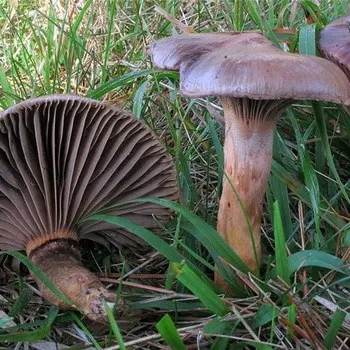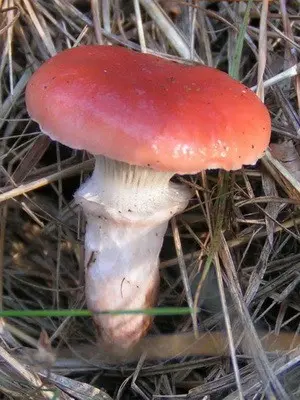 Mokruha pine (purple) – an edible mushroom of the Mokrukhov family with a dense, fleshy hat. We bring to your attention a description and photo of the purple mokruha mushroom, as well as a similar type of pink mokruha. You can also learn about the rules for collecting and using these mushrooms in cooking and traditional medicine.
Mokruha pine (purple) – an edible mushroom of the Mokrukhov family with a dense, fleshy hat. We bring to your attention a description and photo of the purple mokruha mushroom, as well as a similar type of pink mokruha. You can also learn about the rules for collecting and using these mushrooms in cooking and traditional medicine.
Family: Мокруховые (Gomphidiaceae).
Synonyms: mokruha purple, mokruha shiny, mokruha yellow-legged, yellow-legged copper-red.
Description. Hat 3-12 cm in diameter, convex to prostrate, with a slightly bent down edge, red-yellow-brown, sticky, shiny in dry weather. The plates descend down the stem, thick, sparse, olive to yellowish-gray-reddish, reddish-brown, darkening with age. Stalk 4-12 X 1 cm, usually tapering towards the base, fibrous to scaly, almost uniform with a cap, but yellow at the base. The flesh is wine-red, yellow-orange, more yellow in the stem.


The fungus bears fruit often and abundantly in forests with pine, in pine forests, in pine plantations, along heaths, often on hills. Forms mycorrhiza with pine, according to some sources – with birch. Occurs from July to October. Mushrooms growing after autumn frosts often take on a copper-purple color. In Our Country, the fungus mokruha pine (purple) grows throughout the forest zone, except for the Far South and North.
[ »wp-content/plugins/include-me/ya1-h2.php»]
Pink mokruha mushroom: photo and application

Mushroom mokruha pink (Gomphidius roseus) easily distinguishable from C. rutilus. Pay attention to the photo of the mushroom: pink mosquito has a bright pink hat and lighter plates.
Application in folk medicine. In folk medicine, ointments prepared on the basis of alcohol tincture are used against ordinary and neurogenic dermatitis. Other mushrooms for the treatment of dermatitis are red fly agaric, gray dung beetle, yellow chanterelle and pointed fiber.
In the north and northeast of China, this mokruha is one of the main mushrooms collected by the local population, both for medicinal and food purposes.
Collection rules: Collect young fruiting bodies. Alcoholic infusions are used. The ointment is prepared similarly to that of the red fly agaric.
Application in cooking: It is used for frying, it does not require pre-boiling. In terms of taste, it is close to butter, which is the closest relative.









